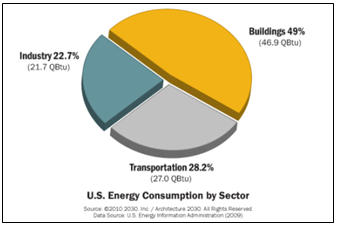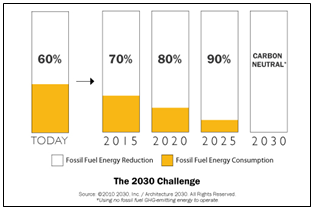|
September 2011
Article
AutomatedBuildings.com
|
[an error occurred while processing this directive]
(Click
Message to Learn More)
|
The “Moon Shot” for Building Energy Performance
The
goals have been set and the bar is high, as we enter a
transitional period where voluntary actions related to building energy
performance will soon be mandatory.
“The true sign of intelligence is not
knowledge but imagination.” Albert Einstein
|
|
 There’s
nothing like an audacious challenge and one is certainly being
set out for building energy performance. The test for building owners,
facility managers, designers and contractors will be to drastically
reduced energy consumption in their buildings. We’re not talking about
15% or even a 30% reduction in energy consumption; something we may be
able to attain and be satisfied with in the here and now. The coming
mandates and regulations, as well as the softer policies and
initiatives, could require 60% or 70% energy consumption reduction and
eventually net-zero buildings with the significant use of renewable
energy. The teeth in this challenge will bite down hard,
primarily in new construction codes which are already in the pipeline,
not to mention the series of new government initiatives and imperatives
that have been set forth by industry groups. What follows is a
recap and assessment of some the upcoming mandates and initiatives and
how they may affect the marketplace.
There’s
nothing like an audacious challenge and one is certainly being
set out for building energy performance. The test for building owners,
facility managers, designers and contractors will be to drastically
reduced energy consumption in their buildings. We’re not talking about
15% or even a 30% reduction in energy consumption; something we may be
able to attain and be satisfied with in the here and now. The coming
mandates and regulations, as well as the softer policies and
initiatives, could require 60% or 70% energy consumption reduction and
eventually net-zero buildings with the significant use of renewable
energy. The teeth in this challenge will bite down hard,
primarily in new construction codes which are already in the pipeline,
not to mention the series of new government initiatives and imperatives
that have been set forth by industry groups. What follows is a
recap and assessment of some the upcoming mandates and initiatives and
how they may affect the marketplace.
 The International Code Council (ICC) – The ICC is the most
serious of
the efforts. They develop building codes for a variety of building
types, addressing fire, plumbing, energy conservation, mechanical
systems, zoning, etc. While the codes are “models”, they are
widely adopted and used as mandates and regulations for governmental
authorities. In the US most every city, county and state uses some ICC
codes as the basis of their construction codes. In addition, ICC codes
are used by the US federal government and are a reference for other
countries around the world. Therefore ICC activity translates into
building codes and regulations adopted around the world.
The International Code Council (ICC) – The ICC is the most
serious of
the efforts. They develop building codes for a variety of building
types, addressing fire, plumbing, energy conservation, mechanical
systems, zoning, etc. While the codes are “models”, they are
widely adopted and used as mandates and regulations for governmental
authorities. In the US most every city, county and state uses some ICC
codes as the basis of their construction codes. In addition, ICC codes
are used by the US federal government and are a reference for other
countries around the world. Therefore ICC activity translates into
building codes and regulations adopted around the world.
The
International Energy Conservation Code (IECC) is an example of
their reach. In 1998 the ICC produced the IECC which set requirements
for the “effective use of energy” in residential and commercial
buildings. Almost 40 US states have adopted the IECC as their mandatory
state code. (Some states don’t have mandatory codes, some
modified the IECC and some developed their own code.) While an
important initiative, many of the adopted energy codes establish legal
minimums for some, but not all energy-related features, and have been
criticized for “gaps” in the general approach.
[an error occurred while processing this directive]
For the
last two years ICC has been developing a new code, the
International Green Construction Code (IGCC), focusing on new and
existing commercial buildings to address green building design and
performance much more comprehensively. The idea as stated by ICC is to
move from voluntary green building programs and rating systems to a
mandatory basis: “the IGCC is poised to produce environmental benefits
on a massive scale: a scale impossible to attain with purely voluntary
green building programs and rating systems”. This effort by ICC has
been sponsored by the American Society for Testing and Materials (ASTM)
and the American Institute of Architects, with coordination by the US
Green Building Council, ASHRAE, IES and the Green Building Initiative
(The Green Globe rating system). The First Edition of the IGCC is
scheduled to be published in March 2012. The IGCC drafts allow
jurisdictions the latitude to identify specific requirements for
energy, water, natural resources and material conservation, but at the
same time reduce the choices for building designers, owners and
contractors.
Central
to the enforcement of the Green Construction Code is a metric
referred to as Total Annual Net Energy Use (TANEU). TANEU is basically
a ratio of the energy performance of the proposed design (minus energy
savings from renewable energy on site and any waste energy recovered on
site from the chiller plant or cogeneration) to the energy performance
of a standard reference design. If you use the year 2009 for a baseline
of 100, the code may require a TANEU of 77% or 65% or whatever the
jurisdiction decides.
The
IGCC essentially takes voluntary rating systems such as LEED and
Green Globe together with industry best practices and crafts it into
regulations aimed at building energy and sustainability performance.
After the implementation of the IGCC via local construction codes it
will be interesting to see if more buildings will become LEED certified
since building owners and designers will be mandated to follow a
process similar to the rating system, or whether there will be less
demand for LEED certification since most buildings will have to follow
similar mandates anyway.
 Architecture
2030 Challenge – Architecture 2030 is a non-profit,
non-partisan and independent organization with support from and
coordination with AIA, ASHRAE, IES, USGBC, the US Department of Energy
and many other groups and associations. The 2030 Challenge establishes
a goal of "zero net energy" buildings by the year 2030. The
agreement specified energy performance targets beginning with an
immediate reduction of 50 percent in energy use for all new buildings.
This target increases rapidly with a 60 percent reduction in 2010,
adding an additional 10 percent reduction every five years, until
carbon neutral buildings are the norm by 2030. While nothing here is
mandated, you have the major industry groups (AIA, ASHRAE, USGBC, IES
the US government) involved and committed, with their membership of
architects and engineers adhering and designing to the policies and
initiatives of their organizations.
Architecture
2030 Challenge – Architecture 2030 is a non-profit,
non-partisan and independent organization with support from and
coordination with AIA, ASHRAE, IES, USGBC, the US Department of Energy
and many other groups and associations. The 2030 Challenge establishes
a goal of "zero net energy" buildings by the year 2030. The
agreement specified energy performance targets beginning with an
immediate reduction of 50 percent in energy use for all new buildings.
This target increases rapidly with a 60 percent reduction in 2010,
adding an additional 10 percent reduction every five years, until
carbon neutral buildings are the norm by 2030. While nothing here is
mandated, you have the major industry groups (AIA, ASHRAE, USGBC, IES
the US government) involved and committed, with their membership of
architects and engineers adhering and designing to the policies and
initiatives of their organizations.
 President’s Climate Commitment – This is a more narrow
initiative and
an example of executive policy that will affect energy performance in a
particular sector, in this case higher education. It is a program
American university and college presidents started in 2006 that
“recognizes the need to reduce the global emission of greenhouse gases
by 80% by mid-century at the latest.” Their commitment is fairly broad;
new construction meeting a minimum of LEED Silver certification,
purchasing appliances that are Energy Star certified, offsetting the
greenhouse gas emission of travel, promoting public transportation,
participating in waste minimization, and finally probably the most
difficult commitment, that is the goal of purchasing or producing 15%
of the institution’s electric consumption from renewable sources. While
none of this is mandatory it does set policy for building energy
performance higher education institutions.
President’s Climate Commitment – This is a more narrow
initiative and
an example of executive policy that will affect energy performance in a
particular sector, in this case higher education. It is a program
American university and college presidents started in 2006 that
“recognizes the need to reduce the global emission of greenhouse gases
by 80% by mid-century at the latest.” Their commitment is fairly broad;
new construction meeting a minimum of LEED Silver certification,
purchasing appliances that are Energy Star certified, offsetting the
greenhouse gas emission of travel, promoting public transportation,
participating in waste minimization, and finally probably the most
difficult commitment, that is the goal of purchasing or producing 15%
of the institution’s electric consumption from renewable sources. While
none of this is mandatory it does set policy for building energy
performance higher education institutions.
Net-Zero Buildings
The end game here of the mandates, policies and initiatives and the
severe reduction of building energy consumption is to demonstrate
net-zero buildings (however defined) by 2025, followed by substantial
deployment of such buildings by 2030, all done in concert with
substantial use of renewable energy. Institutions such as the US
Department of Energy and ASHRAE are supporting the effort with ASHRAE
developing the tools necessary to design, build and operate net-zero
energy buildings. Overall, the current number of net-zero
buildings is minimal, many are associated with environmental or
academic organizations not commercial buildings, and the square footage
of the average net zero facility is relatively small.
The challenge of drastic reductions of building energy consumption and
widespread deployment of net zero buildings is similar to the goal of
landing a man on the Moon that was made 49 years ago; it has broad
support, there is awareness that not all the technologies required are
developed or even identified, there’s a huge need and opportunity for
innovative engineering, and there are eventual benefits to economies
and to the world in general. In many ways however, the challenge for
building energy performance is much more difficult than the Moon shot;
rather than one focused government agency leading the effort, reducing
energy consumption in buildings will involve of millions of
individuals. The goals have been set and the bar is high, as we enter a
transitional period where voluntary actions related to building energy
performance will soon be mandatory.
For more information, write us at info@smart-buildings.com.
footer
[an error occurred while processing this directive]
[Click Banner To Learn More]
[Home Page] [The
Automator] [About] [Subscribe
] [Contact
Us]
